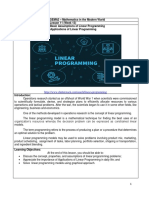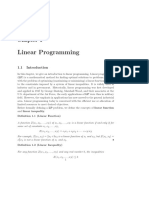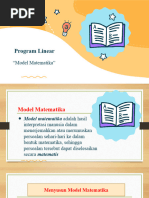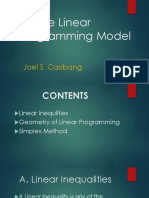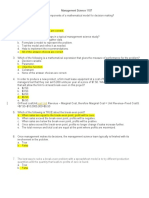0 ratings0% found this document useful (0 votes)
19 viewsLinear Programming
Linear Programming
Uploaded by
SyedLinear programming was developed in 1939 and extended in 1947 to solve optimization problems with multiple variables and constraints. It can be used to find optimal solutions for processes, product mixes, and satisfying requirements. A linear programming problem is formulated by defining variables, constraints as linear equations/inequalities, and the objective function to maximize or minimize. The solution is found by plotting the constraints, identifying the feasible region, and choosing the point that optimizes the objective function subject to the constraints.
Copyright:
© All Rights Reserved
Available Formats
Download as PPTX, PDF, TXT or read online from Scribd
Linear Programming
Linear Programming
Uploaded by
Syed0 ratings0% found this document useful (0 votes)
19 views10 pagesLinear programming was developed in 1939 and extended in 1947 to solve optimization problems with multiple variables and constraints. It can be used to find optimal solutions for processes, product mixes, and satisfying requirements. A linear programming problem is formulated by defining variables, constraints as linear equations/inequalities, and the objective function to maximize or minimize. The solution is found by plotting the constraints, identifying the feasible region, and choosing the point that optimizes the objective function subject to the constraints.
Original Title
Untitled
Copyright
© © All Rights Reserved
Available Formats
PPTX, PDF, TXT or read online from Scribd
Share this document
Did you find this document useful?
Is this content inappropriate?
Linear programming was developed in 1939 and extended in 1947 to solve optimization problems with multiple variables and constraints. It can be used to find optimal solutions for processes, product mixes, and satisfying requirements. A linear programming problem is formulated by defining variables, constraints as linear equations/inequalities, and the objective function to maximize or minimize. The solution is found by plotting the constraints, identifying the feasible region, and choosing the point that optimizes the objective function subject to the constraints.
Copyright:
© All Rights Reserved
Available Formats
Download as PPTX, PDF, TXT or read online from Scribd
Download as pptx, pdf, or txt
0 ratings0% found this document useful (0 votes)
19 views10 pagesLinear Programming
Linear Programming
Uploaded by
SyedLinear programming was developed in 1939 and extended in 1947 to solve optimization problems with multiple variables and constraints. It can be used to find optimal solutions for processes, product mixes, and satisfying requirements. A linear programming problem is formulated by defining variables, constraints as linear equations/inequalities, and the objective function to maximize or minimize. The solution is found by plotting the constraints, identifying the feasible region, and choosing the point that optimizes the objective function subject to the constraints.
Copyright:
© All Rights Reserved
Available Formats
Download as PPTX, PDF, TXT or read online from Scribd
Download as pptx, pdf, or txt
You are on page 1of 10
Linear Programming
Linear programming was developed by the Russian
mathematician L. V. Kantorovich in 1939 and extended
by the American mathematician G. B. Dantzig in 1947.
Simple linear programming problems with only a few
variables are easily solved graphically or algebraically.
More complex problems are invariably solved by the
use of computers.
Assumptions of Linear Programming
• There are a number of constraints or restrictions expressible in
quantitative terms.
• The prices of input and output both are constant.
• The relationship between the objective function and constraints are
linear.
• The objective function is to be optimized i.e., profit maximization or
cost minimization.
Applications of Linear Programming
• Linear programming has been applied to a wide variety of constrained
optimization problems. Some of these are:
1. Optimal process selection
2. Optimal product mix.
3. Satisfying minimum product requirements
FORMULATION OF A LINEAR
PROGRAMMING PROBLEM
• The formulation of a linear programming problem as a mathematical
model involves the following key steps.
• Step 1:Identify the decision variables to be determined and express
them in terms of algebraic symbols such as X1, X2, X3-
• Step 2:Identify all the limitations in the given problem and then
express them as linear equations or inequalities in terms of above
defined decision variables.
• Step 3:Identify the objective which is to be optimized (maximized or
minimized) and express it as a linear function of the above defined
decision variables.
STEPS FOLLOWED IN SOLVING A
LINEAR PROGRAMMINGPROBLEM
The steps followed in solving a linear programming problem are:
1. Express the objective function of the problem as an equation and the constraints
as inequalities
2. Constraints are changed into equalities.
3. Plot the constraints on the graph.
4. Identify the feasible region and ascertain their coordinates.
5. Find the optimal solution (i.e., the values of the decision variables) at the extreme
point or corner of the feasible region that touches the highest profit line or the
lowest cost line.
This represents the optimal solution to the problem subject to the constraints faced.
Example
Niki holds two part-time jobs, Job I and Job II. She never wants to work
more than a total of 12 hours a week. She has determined that for
every hour she works at Job I, she needs 2 hours of preparation time,
and for every hour she works at Job II, she needs one hour of
preparation time, and she cannot spend more than 16 hours for
preparation.
If Niki makes $40 an hour at Job I, and $30 an hour at Job II, how many
hours should she work per week at each job to maximize her income?
Well, good news! We have formulated the problem. We restate it as
Maximize: Z=40x+30y
Subject to: x+y≤12
2x+y≤16
x≥0;y≥0
Solution
Step 1 change all inequalities to equalities
X+Y=12
2X+Y= 16
X+Y=12 (0,12) (12,0)
2X+Y= 16 (0,16) (8,0)
Place the values and find the feasible solution
A (0, 0) 40(0) + 30(0) = $0
B (0, 12) 40(0) + 30(12) = $360
C (4, 8) 40(4) + 30(8) = $400
D (8, 0) 40(8) + 30(0) = $320
Clearly, the point (4, 8) gives the most profit: $400.
Therefore, we conclude that Niki should work 4 hours at Job
I, and 8 hours at Job II.
You might also like
- ch19 PDFDocument23 pagesch19 PDFDonita BinayNo ratings yet
- Practical Earned Value Analysis: 25 Project Indicators from 5 MeasurementsFrom EverandPractical Earned Value Analysis: 25 Project Indicators from 5 MeasurementsNo ratings yet
- Advanced C++ Interview Questions You'll Most Likely Be AskedFrom EverandAdvanced C++ Interview Questions You'll Most Likely Be AskedNo ratings yet
- HESI A2 Math Practice Tests: HESI A2 Nursing Entrance Exam Math Study GuideFrom EverandHESI A2 Math Practice Tests: HESI A2 Nursing Entrance Exam Math Study GuideNo ratings yet
- Linear Programming IDocument16 pagesLinear Programming IS PatNo ratings yet
- FinalDocument13 pagesFinalseetha1981skNo ratings yet
- Operation Research Lab Manual - Lab 02Document7 pagesOperation Research Lab Manual - Lab 02Atif Hussain100% (1)
- Lectures PDFDocument167 pagesLectures PDFPriyadi Widodo100% (1)
- Linear Programming - Group 1Document41 pagesLinear Programming - Group 1Meryl BolilanNo ratings yet
- Chapter 2 - Linear ProrammingDocument67 pagesChapter 2 - Linear ProrammingLetaNo ratings yet
- Chapter3 AFM3CDocument13 pagesChapter3 AFM3Caljon singlaoNo ratings yet
- 3.1 Maximization ApplicationsDocument13 pages3.1 Maximization ApplicationsEbrahim Siddiky 182-15-2116No ratings yet
- Mgmt114n - Module 3 Linear ProgrammingDocument77 pagesMgmt114n - Module 3 Linear Programminglyriemaecutara0No ratings yet
- SOL - DU - MBAFT-6202 Decision Modeling and Optimization With Distributed NetworkDocument45 pagesSOL - DU - MBAFT-6202 Decision Modeling and Optimization With Distributed NetworkAmish SinghNo ratings yet
- LPP MCQ 1Document12 pagesLPP MCQ 1Ankit Dubey100% (2)
- LPPDocument5 pagesLPPdheerajgulati_31100% (4)
- Qbmscca040020206 PDFDocument33 pagesQbmscca040020206 PDFjimitNo ratings yet
- Quantitative Analysis BA 452 Homework 1 QuestionsDocument70 pagesQuantitative Analysis BA 452 Homework 1 Questionssubash1111@gmail.com100% (6)
- Q#1LPPDocument3 pagesQ#1LPPzainitara786No ratings yet
- 4_Module 4_Unit 3_Linear Programming Models_2037274932Document32 pages4_Module 4_Unit 3_Linear Programming Models_2037274932wasitrizzaNo ratings yet
- Linear ProgrammingDocument77 pagesLinear ProgrammingDiane Marinel De LeonNo ratings yet
- EDITED-MODULE - in Mathematics in - The Modern - World - Week-13Document6 pagesEDITED-MODULE - in Mathematics in - The Modern - World - Week-13Class LectureNo ratings yet
- CW2 Multiple Representations of Linear FunctionsDocument17 pagesCW2 Multiple Representations of Linear FunctionspaulprovenceNo ratings yet
- Linear-Programming-Group-8 20231211 115438 0000Document31 pagesLinear-Programming-Group-8 20231211 115438 0000Marivic BorbeNo ratings yet
- Module 2 Linear ProgrammingDocument8 pagesModule 2 Linear Programmingyvonne quiambaoNo ratings yet
- PAN African e Network Project: Semester - 1Document75 pagesPAN African e Network Project: Semester - 1westerNo ratings yet
- Mission:: Program Development Life Cycle (PDLC) Problem Solving Concepts (Part 2)Document3 pagesMission:: Program Development Life Cycle (PDLC) Problem Solving Concepts (Part 2)NARVENESH A L GEVARATNAMNo ratings yet
- Graphical Solution of Linear Programming ProblemsDocument2 pagesGraphical Solution of Linear Programming ProblemsHetaldamaniNo ratings yet
- Linear ProgrammingDocument46 pagesLinear ProgrammingRhea Angeline GarciaNo ratings yet
- Quntiative Techniques 2 SonuDocument11 pagesQuntiative Techniques 2 SonuSonu KumarNo ratings yet
- Lesson 03 Graphical Method For Solving L PPDocument19 pagesLesson 03 Graphical Method For Solving L PPMandeep SinghNo ratings yet
- Chapter 2Document29 pagesChapter 2Lyana JaafarNo ratings yet
- Linear Programming Is The Simplest Way of Optimizing A ProblemDocument13 pagesLinear Programming Is The Simplest Way of Optimizing A Problemgssgopi9_389290943No ratings yet
- PS_5_2024_with_ansDocument5 pagesPS_5_2024_with_ansabhiNo ratings yet
- Digital Logic QuizDocument1 pageDigital Logic QuizJustin VillocidoNo ratings yet
- Linear Programming: Formulation & ApplicationsDocument10 pagesLinear Programming: Formulation & ApplicationsJhonrick MagtibayNo ratings yet
- X 213231124Document23 pagesX 213231124Seave HwangNo ratings yet
- MMW Module 5.2 - Linear Programming & APPLICATIONSDocument6 pagesMMW Module 5.2 - Linear Programming & APPLICATIONSGhillian Mae GuiangNo ratings yet
- Operation Research Lab Manual - Lab 03Document5 pagesOperation Research Lab Manual - Lab 03Atif HussainNo ratings yet
- Linear Programming Model Graphical MethodDocument8 pagesLinear Programming Model Graphical MethodKisha Kaye Del ValleNo ratings yet
- Finals SmathDocument4 pagesFinals SmathJoana TrinidadNo ratings yet
- Linear ProgrammingDocument68 pagesLinear ProgrammingMy ANo ratings yet
- Linear Programming - Final 1Document89 pagesLinear Programming - Final 1Gagan GoyalNo ratings yet
- Linear Programming (Maximisation and Minimisation)Document35 pagesLinear Programming (Maximisation and Minimisation)Afzal Khan100% (2)
- Linear Programming: Model Formulation and Graphical SolutionDocument65 pagesLinear Programming: Model Formulation and Graphical SolutionPatrice Elaine PillaNo ratings yet
- LINEAR PROGRAMMING - Lesson 2 PDFDocument39 pagesLINEAR PROGRAMMING - Lesson 2 PDFCristel ObraNo ratings yet
- Maximizing The Profit of A Business-FinalDocument3 pagesMaximizing The Profit of A Business-Finalapi-192489685No ratings yet
- Program Linear 03Document35 pagesProgram Linear 03Eleana ClaraNo ratings yet
- Linear ProgrammingDocument13 pagesLinear ProgrammingOlaniyi EvansNo ratings yet
- Simple Linear Programming Model: Joel S. CasibangDocument49 pagesSimple Linear Programming Model: Joel S. CasibangMichelle Dela CruzNo ratings yet
- Management Science 1107 - Midterms AnswersDocument4 pagesManagement Science 1107 - Midterms AnswersHans DelimaNo ratings yet
- Linear ProgrammingDocument37 pagesLinear ProgrammingAlliahData0% (1)
- Chapter Two-Linear ProrammingDocument55 pagesChapter Two-Linear Prorammingeyobirhanu1992No ratings yet
- Master of Business Administration: Quantitative Analysis For Management DecisionsDocument75 pagesMaster of Business Administration: Quantitative Analysis For Management DecisionsDawit TesfayeNo ratings yet
- OR - CH - 2Document26 pagesOR - CH - 2gadisafufa81No ratings yet
- Linear ProgrammingDocument24 pagesLinear ProgrammingAlayssa Silva-Mercado0% (1)
- Programming in Visual Basic (VB): For Visual StudioFrom EverandProgramming in Visual Basic (VB): For Visual StudioNo ratings yet
- Pre-Calculus All-in-One For Dummies: Book + Chapter Quizzes OnlineFrom EverandPre-Calculus All-in-One For Dummies: Book + Chapter Quizzes OnlineNo ratings yet
- Let's Practise: Maths Workbook Coursebook 6From EverandLet's Practise: Maths Workbook Coursebook 6No ratings yet
- Solving The Cubic and QuarticDocument4 pagesSolving The Cubic and Quarticworksmsy2563No ratings yet
- Numerical Methods in Chemical Engineering (CB424)Document33 pagesNumerical Methods in Chemical Engineering (CB424)Siddhant SoymonNo ratings yet
- GAUSSDocument4 pagesGAUSSMarshall james G. RamirezNo ratings yet
- MTH603 Mcqs MidTerm by Vu Topper RMDocument40 pagesMTH603 Mcqs MidTerm by Vu Topper RMHarley Quinn OfficialNo ratings yet
- Homework 3Document10 pagesHomework 3Surya TejaNo ratings yet
- Experiment No.5: Branch and Bound AlgorithmDocument6 pagesExperiment No.5: Branch and Bound AlgorithmAmisha SharmaNo ratings yet
- CIVL512 Finite Element Methods (FEM)Document51 pagesCIVL512 Finite Element Methods (FEM)ceice2013No ratings yet
- Grade 10 Polynomials Za PDFDocument2 pagesGrade 10 Polynomials Za PDFLuyanda MampaneNo ratings yet
- 3.4 Hermite Interpolation 3.5 Cubic Spline InterpolationDocument26 pages3.4 Hermite Interpolation 3.5 Cubic Spline Interpolationsal27adamNo ratings yet
- Numerical Solution of A Differential Equation: Module-4Document21 pagesNumerical Solution of A Differential Equation: Module-4RishitaNo ratings yet
- Numerical Methods For Scientists and Engineers by K. S. RaoDocument123 pagesNumerical Methods For Scientists and Engineers by K. S. RaoMeliza SouzaNo ratings yet
- Chapter 6 Assignment ModelDocument51 pagesChapter 6 Assignment ModelKlarence Corpuz LeddaNo ratings yet
- Integration - Unequal Segments, Multiple Integral and Gauss Quad RuleDocument31 pagesIntegration - Unequal Segments, Multiple Integral and Gauss Quad RulemoatazNo ratings yet
- Numerical Optimization: Lecture Notes #24 Nonlinear Least Squares - Orthogonal Distance RegressionDocument21 pagesNumerical Optimization: Lecture Notes #24 Nonlinear Least Squares - Orthogonal Distance RegressionemwlupeNo ratings yet
- Cubic SolutionDocument4 pagesCubic SolutionJayabalan R KNo ratings yet
- Knapsack LectDocument17 pagesKnapsack Lectazeemahmad570No ratings yet
- M10-3rd TOPIC - Division of PolynomialsDocument54 pagesM10-3rd TOPIC - Division of PolynomialsClara ChuNo ratings yet
- Lecture 03 OdEDocument58 pagesLecture 03 OdEcuntnaszerNo ratings yet
- Nonlinear Programming Concepts PDFDocument224 pagesNonlinear Programming Concepts PDFAshoka VanjareNo ratings yet
- IT-502041-Numerical Analysis-Chapter 02-Roots of Equations in One VariableDocument93 pagesIT-502041-Numerical Analysis-Chapter 02-Roots of Equations in One VariableTrọng Phúc LêNo ratings yet
- BCA II Numerical Internal IstDocument2 pagesBCA II Numerical Internal Istlove.vishwakarmaNo ratings yet
- Maxima and Minima of Functions of Two VariablesDocument10 pagesMaxima and Minima of Functions of Two Variablesmurtaza.anwer.10No ratings yet
- Quiz 2: 2.29 Numerical Fluid Mechanics - Spring 2015Document6 pagesQuiz 2: 2.29 Numerical Fluid Mechanics - Spring 2015Ihab OmarNo ratings yet
- OR1 03 IPmodelingDocument45 pagesOR1 03 IPmodelinghamzatamer.88.10No ratings yet
- Classifying-Polynomials - Worksheet-With-AnswersDocument2 pagesClassifying-Polynomials - Worksheet-With-Answersapi-28892207225% (4)
- MTsolDocument5 pagesMTsolhangyujuNo ratings yet
- Economic Dispatch by Equal Incremental Cost Criterion PDFDocument4 pagesEconomic Dispatch by Equal Incremental Cost Criterion PDFdubuli123100% (1)
- CN 5 Limit of Polynomial and Rational FunctionsDocument2 pagesCN 5 Limit of Polynomial and Rational FunctionsDenise Nicole T. LopezNo ratings yet
- 10 - Factorization Using Cross MultiplicationDocument2 pages10 - Factorization Using Cross MultiplicationKaslon SimbolonNo ratings yet
- 10M02 - Polynomials - Subjective Test (JS - M - 62 - 19)Document1 page10M02 - Polynomials - Subjective Test (JS - M - 62 - 19)neomatrix70No ratings yet





















